How To Fish Sunrise Lake
Sunrise Lake Fishing Report
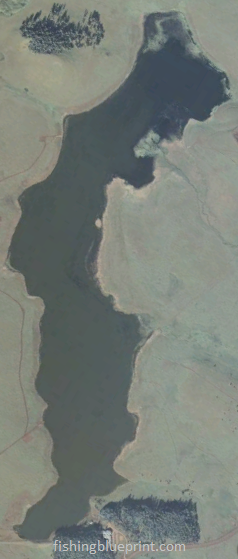
Show Low Lake is a small community lake in the heart of Show Low, Arizona, making it 184 miles from Phoenix, Arizona.
Overall it’s a popular lake especially on the weekends and during the summer. In this post you’re going to be given the blueprint to fish this lake.
So what are the best tips for fishing Show Low Lake? There are three important factors you must know if you want to know how to fish Show Low Lake successfully. First, you need to know what kind of fish is in Show Low Lake. Second, it’s important for you to know which part of the lake each species can be found. Lastly, knowing what are the best baits that work on Show Low Lake is vital. However, tactics, baits, and locations will be different for each type of fish that you target. So let’s talk about the steps you need to take in order to give you the best chance of catching a fish on Show Low Lake.
WARNING: There’s a lot of information about this subject you’ll probably want to come back to. No one expects you to remember all these tips. We know your time is precious, so we really tried to over-deliver in value for you. Additionally, we frequently update reports like this, so you’ll want to stay up to date with any changes or additional tips we include for you.
We found that the easiest way to save and bookmark this report so you can come back to it later is to share it on your favorite social media platform, especially if you use your phone to get important tips like the ones in this report here…
Click on your favorite social media buttons to remember this page now!
About Sunrise Lake
Sunrise Lake is a shallow body of water with the average depth being 15 feet and a maximum depth of 35 feet when the lake is completely full. Being 1.3 miles long and 0.35 miles across. This reservoir plays a vital role in snowfall runoff retention. Located in the eastern part of Arizona, Sunrise Lake gives locals and visitors the opportunity to test their luck in catching a huge Rainbow trout, Skamania trout, and Lake trout.
Important Lake Warnings
Algae blooms may be present which may affect fishing, swimming, and water contact in general.
Maximum 10-HP for gas engines on the lake.
If you are fishing and camping, fire bans may be in effect due to the ongoing drought conditions.
What Kind of Fish Are In Sunrise Lake
- Rainbow Trout
- Brown Trout
- Skamania Trout
- Tiger Trout
- Sunfish
- Catfish
Sunrise Lake Fishing Tips & General Strategies
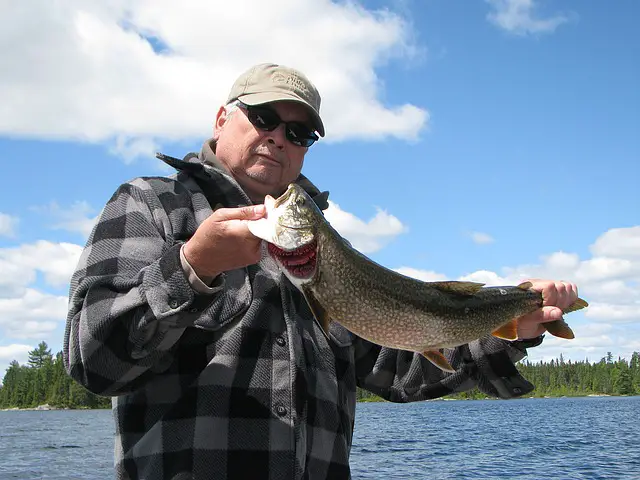
It can be a challenge to break down Sunrise Lake and decide to get started.
Getting started, Sunrise Lake is a stained water lake and fishing can be tough.
The primary structures are going to be a large creek channel that runs down the middle of the lake.
The banks vary from semi-steep to gentle sloping. Most banks consist of chunk rock and pea-gravel. Some areas have sand and clay.
By far you’ll have the best opportunity to catch a fish if you can present your bait to fish that are in deep water.
Trout in this lake are extremely pelagic and hunt in small schools.
This lake is absolutely beautiful, open, and accessible to nearly everybody. It’s convenient since there are paths that go along the lake’s shore.
Often you’ll see a huge herd of Elk grazing on the hills is regularly visible in the early morning and late evening.
You can easily fish from the shore or from a boat or kayak.
Trout can be found up shallow in the winter and spring. However, trout will often suspend over deep water and more importantly in water temperatures that range from 55.5-56.5-degrees.
Your best chance of catching deep suspending rainbow trout is by trolling your lure with a quality downrigger. Otherwise, you can drift or slow troll trout using a fly, corn, wax worm, salmon egg, or PowerBait.
But where are the best places to fish At Sunrise Lake?
And in no particular order here is that list of the best fishing spots at Sunrise Lake.
DISCLAIMER: The material provided is for general information purposes only. It’s important to understand that any information provided in this article can change at any time. Any maps or graphics featured are not to be used as navigational aids. Fishing Blueprint will not be responsible for any personal injury or property damage from any misuse of the maps or graphics provided. It’s completely impossible to give you every single spot where you can potentially catch a fish. But, what this list does do is to give you a helping hand and narrow down to the most productive fishing spots.
Sunrise Lake Dam
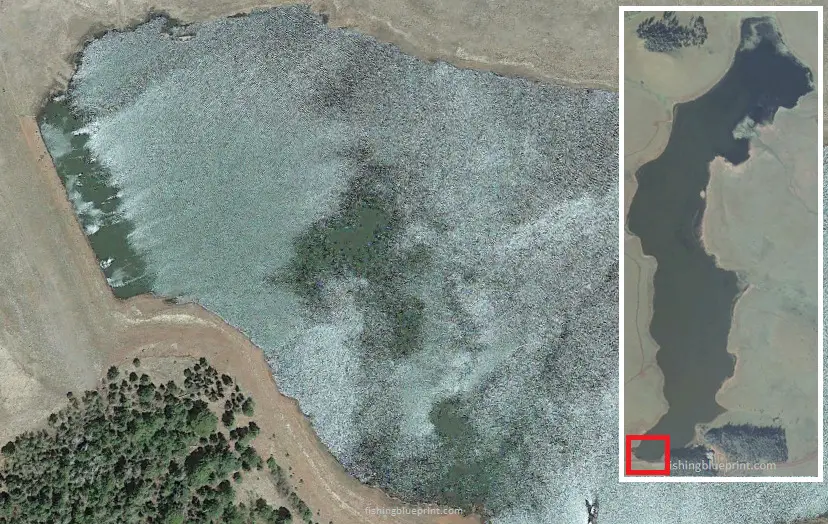
Fishing around the dam provides you access to the deepest water this lake has to offer.
It’s important that you graph this area to see what depth the trout are holding at. Then you can easily adjust your lure depth to just above the suspending depth.
This section of the lake can get very windy. And even with the best trolling motor, the wind can quickly blow you off your spot which will significantly decrease your chances of catching a fish.
That is why we strongly suggest buying a quality drift sock. For those who don’t know, a drift sock is like a parachute for the water. If it’s breezy to windy, you need to slow your drift otherwise your lure will not be in the strike zone long enough to catch a fish.
By the way, we found a really good quality drift sock made by Mythik Outdoors, and best of all they’re sold on Amazon.com. Go here to learn more about drift socks and read the reviews from actual customers.
Some of the effective baits for this area include:
But wait! Before you tie on any bait nearly every professional fishing guide will strongly encourage the use of a fish attractor like a quality flasher or dodger 2-3 feet in front of any lure. This helps get the fish’s attention, kinda like ringing a dinner bell!
Trolling spoons such as a Krocodile spoon, Super Duper, Crippled Herring, Cast Champ, or Hus-Lure. Trolling spoons have an unpredictable, minnow-like motion that delivers bone-crushing strikes. Even the slowest current brings these lures to life. Add extra motion by twitching the rod tip and enabling the bait to pop and dart forward and flutter back.
Inline spinners such as the Bang-Tail and Shyster are non-twist spinners that boast an immediate spin blade design for incredibly rapid start-ups and the best slow retrieve performance.
Many anglers also place their confidence in the Blue Fox Classic Vibrax inline spinner. This little bait is a compact shallow running lure that performs best in 2 to 6 feet of water, depending on the speed of the retrieve or trolling speed. The patented two-part body emits low-frequency sound vibrations that attract fish. This lure is best used in lakes, rivers, and streams.
Minnow style baits also work very well either cast-and-retrieved or trolled. These perform best if the water is clear/slightly stained. The Luhr-Jensen Quick Fish and the Rapala BX minnow are constructed from hard plastic, have a wide wobble action, and are extremely durable. Whereas the Rapala Original Floating Minnow and the Ultra Light Minnow (all are slow sinking) both give you a tighter wobble perfect for clear water and pressured fishing conditions.
Better yet, just buy a complete done-for-you trout lure kit!
Now if you’re fishing from a boat, float tube, kayak, or even from the shore you should also consider using these additional baits:
- Real or artificial corn – great because it will never spoil or mold over
- Natural salmon eggs – it’s hard to beat natural salmon eggs when trout are eating them. Sometimes you can go through a couple of jars of these eggs in an hour!
- Artificial salmon eggs – great because they float off the bottom – ideal in rocky or grassy conditions
- Real worms – such as meal worms or nightcrawlers
- Artificial worms – great for trolling and will never die)
- Dough bait – great because they stay on the hook really well, it floats if you put enough on the hook, come in a variety of colors and scents.
- Wet flies (sinking flies) – Wet flies imitate insects that develop and inhabit below the water level before emerging and rising to the surface.
- Woolly bugger flies – One of the most popular fly patterns ever is the Woolly Bugger. These mimic small fish, leeches, larvae, and worms.
- Steamer flies – They can also mimic larger animals found in streams and rivers, including crawfish, larger leeches, and smaller fish.
.
Oh, before I forget, did you know that there is an article about how to troll for salmon, trout, and kokanee the right way? Go here to find out more.
If you’re fishing from the shore during the summer anywhere in this area I would strongly recommend it.
Located: western end of the lake
Structural features: deep water
Best species to target: trout
Most effective way to fish this spot: boat, kayak, float tube, shoreline
Points On The Northside Of The Lake
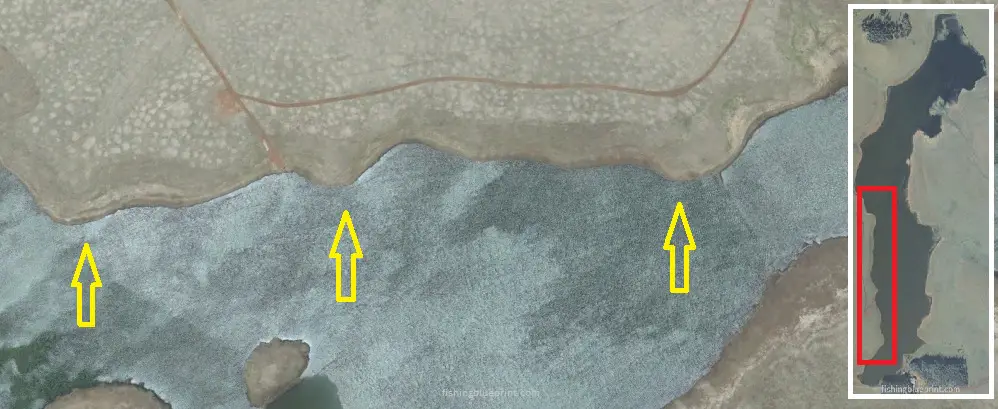
Nearly every point on the north side of the lake quickly drops into deeper water. That’s important if the trout are deeper in the summer.
Look closely…

Effective baits include: Fish attractor (ie: flasher or dodger), trolling spoons, inline spinners, Rapala minnows, Quick Fish, streamers and flies. You can also use real or artificial corn, natural salmon eggs, artificial salmon eggs, real worms such as meal worms or nightcrawlers, artificial worms, and dough bait. Better yet, just buy a complete done-for-you trout lure kit!
Located: northern side of the lake
Structural features: points dropping into deeper water
Best species to target: trout
Most effective way to fish this spot: boat, kayak, float tube, shoreline
Southside Sloping Points
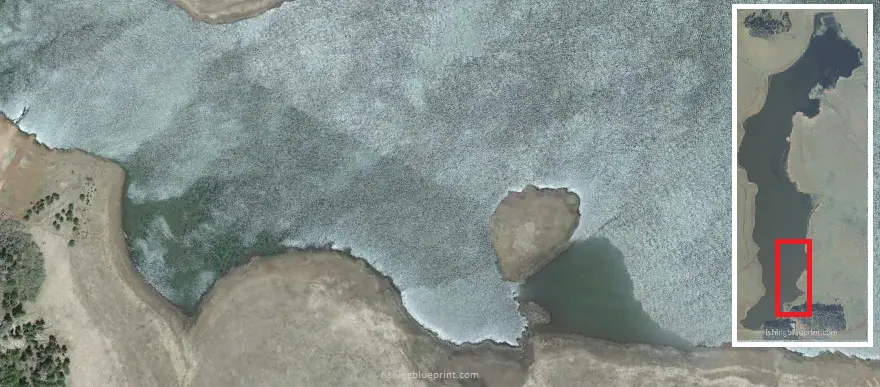
The banks of the points on the southside of the lake have a much gentler slope which makes these spots really good if the trout are higher in the water column as they commonly are found in the spring and fall.
Effective baits include: Fish attractor (ie: flasher or dodger), trolling spoons, inline spinners, Rapala minnows, Quick Fish, streamers and flies. You can also use real or artificial corn, natural salmon eggs, artificial salmon eggs, real worms such as meal worms or nightcrawlers, artificial worms, and dough bait. Better yet, just buy a complete done-for-you trout lure kit!
Located: southern side of the lake
Structural features: gentle sloping points dropping into deeper water
Best species to target: trout
Most effective way to fish this spot: boat, kayak, float tube, shoreline
How To Catch A Fish In Sunrise Lake
Rainbow Trout
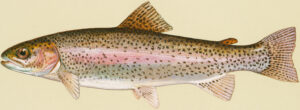 Arizona Game & Fish Department grow and stocks local lakes and reservoirs like this lake with Rainbow Trout.
Arizona Game & Fish Department grow and stocks local lakes and reservoirs like this lake with Rainbow Trout.
Due to this lake being relatively unpressured, deep, and colder, and most other desert reservoirs, the stocked trout do very well.
Since the trout are produced in local fisheries, they are healthy and have no limit on the amount of trout that can be consumed.
Typically trout are stocked twice a week, however, it can vary.
The best spinners are: Bang-Tail (size 018), Blue Foxes (blade size-0), Kastmasters (1/16-ounce), Panther Martins spinners, Little Cleo spoons (1/16-ounce), and Shyster spinners (size 018).
General Trout Details
Spawn: March-May
Food: insects and crustaceans.
Arizona State Record: 15 lb. 9.12 oz. 32.5 in., Willow Springs Lake Harold Wright, Sun City 9/29/06
Table Quality: Depending on the fishes diet, the meat can be white to orange-red in color. The meat is firm, flaky, and is considered excellent eating.
Angling techniques:
- Trolling with or without downriggers
- Fish attractor such as a flasher or a dodger – great when trolling.
- Trolling spoons such as a Krocodile spoon, Super Duper, Crippled Herring, Cast Champ, or Hus-Lure – simple, easy to use, can be trolled or cast-retrieved at any speed.
- Inline spinners such as the Bang-Tail and Shyster – gets a ton of bites.
- Minnow style baits such as the Luhr-Jensen Quick Fish and the Rapala BX minnow – known to hook up giant fish.
- Real or artificial corn – great because it will never spoil or mold over.
- Natural salmon eggs – it’s hard to beat natural salmon eggs when trout are eating salmon eggs, they’ll eat up jars of this stuff!
- Artificial salmon eggs – great because they float off the bottom – ideal in rocky or grassy conditions.
- Real worms – such as meal worms or nightcrawlers.
- Artificial worms – great for trolling and will never die.
- Dry flies (floating flies) – The insects that land, float, or live on top of the water, which are represented by dry flies.Investing in a kit gives you a wide assortment of flies and a good selection of types and sizes allow you to quickly adjust to any situation.
- Wet flies (sinking flies) – Wet flies imitate insects that develop and inhabit below the water level before emerging and rising to the surface. Investing in a kit gives you a wide assortment of flies and a good selection of types and sizes allow you to quickly adjust to any situation.
- Woolly bugger flies – One of the most popular fly patterns ever is the Woolly Bugger. These mimic small fish, leeches, larvae, and worms. Investing in a kit gives you a wide assortment of flies and a good selection of types and sizes allow you to quickly adjust to any situation.
Steamer flies – They can also mimic larger animals found in streams and rivers, including crawfish, larger leeches, and smaller fish. Investing in a kit gives you a wide assortment of flies and a good selection of types and sizes allow you to quickly adjust to any situation.
- **The number one key to successful trout fishing, is to use light line (2 to 6 pound) and small hooks (10-14 sizes), and small sinkers
Brown Trout
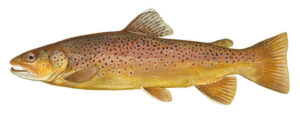 In Arizona, this is the only fish with both red and black patches on its body.
In Arizona, this is the only fish with both red and black patches on its body.
A pale/off-white halo usually surrounds dark patches on the sides.
On the back, the color ranges from dark to olive brown, dipping to yellow on the sides, and yellow or white on the belly.
In larger fish, breeding males have lower chin that will create a hooked jaw. The corner of the mouth extends past the eye, resulting in a huge mouth.
Brown trout are not native to Arizona, nor to North America for that matter. They were first imported to California in 1893 and originated in Europe.
Brown trout will commonly feed during the day if they are not bothered. Larger fish, on the other hand, are mainly nocturnal.
Brown trout are very aggressive feeders and will readily eat a streamer fly, casting upstream or into the wind.
Artificial baits such as in-line spinners or small Rapala minnow bait work phenomenally.
Live nightcrawlers, or minnows on a #6-#8 hooks are excellent baits.
If you can find any waterfall or spillway, spend some time fishing it because brown trout will often wait to ambush any prey that happens to drift over them in those areas.
Likewise, if you’re in a boat on the main lake some of the best ways to catch brown trout is to troll for these behemoths.
General Trout Details
Spawn: October-December
Food: Insects, small fish and crustaceans.
Arizona State Record: 22 lbs 14.5 oz. Caught 08/06/1999 in Reservation Lake.
Table Quality: Depending on the fishes diet, the meat can be white to orange-red in color. The meat is firm, flaky, and is considered excellent eating.
Angling techniques:
- Trolling with or without downriggers
- Fish attractor such as a flasher or a dodger – great when trolling.
- Trolling spoons such as a Krocodile spoon, Super Duper, Crippled Herring, Cast Champ, or Hus-Lure – simple, easy to use, can be trolled or cast-retrieved at any speed.
- Inline spinners such as the Bang-Tail and Shyster – gets a ton of bites.
- Minnow style baits such as the Luhr-Jensen Quick Fish and the Rapala BX minnow – known to hook up giant fish.
- Real or artificial corn – great because it will never spoil or mold over.
- Natural salmon eggs – it’s hard to beat natural salmon eggs when trout are eating salmon eggs, they’ll eat up jars of this stuff!
- Artificial salmon eggs – great because they float off the bottom – ideal in rocky or grassy conditions.
- Real worms – such as meal worms or nightcrawlers.
- Artificial worms – great for trolling and will never die.
- Dry flies (floating flies) – The insects that land, float, or live on top of the water, which are represented by dry flies.Investing in a kit gives you a wide assortment of flies and a good selection of types and sizes allow you to quickly adjust to any situation.
- Wet flies (sinking flies) – Wet flies imitate insects that develop and inhabit below the water level before emerging and rising to the surface. Investing in a kit gives you a wide assortment of flies and a good selection of types and sizes allow you to quickly adjust to any situation.
- Woolly bugger flies – One of the most popular fly patterns ever is the Woolly Bugger. These mimic small fish, leeches, larvae, and worms. Investing in a kit gives you a wide assortment of flies and a good selection of types and sizes allow you to quickly adjust to any situation.
Steamer flies – They can also mimic larger animals found in streams and rivers, including crawfish, larger leeches, and smaller fish. Investing in a kit gives you a wide assortment of flies and a good selection of types and sizes allow you to quickly adjust to any situation.
- **The number one key to successful trout fishing, is to use light line (2 to 6 pound) and small hooks (10-14 sizes), and small sinkers
Brook Trout
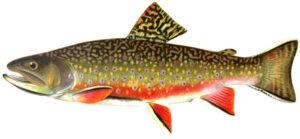 Brook trout are the only fish in Arizona with a vermiculate appearance on their backs and upper sides that appears wavy, almost worm-like.
Brook trout are the only fish in Arizona with a vermiculate appearance on their backs and upper sides that appears wavy, almost worm-like.
They have red specks encircled by blue halos and are olive-green to olive-brown in color, with reddish tints.
Pectoral, pelvic, and anal fins with white-leading edges are the most prominent features of a brook trout.
Brook trout are opportunistic eaters who eat tiny crawfish, worms, minnows, and terrestrial and aquatic invertebrates.
They eat whatever is accessible to them. Anglers love them because they can accept a variety of flies and lures and are not as finicky as other species of trout.
Brook Trout fishing is comparable to Rainbow Trout fishing in rivers or lakes.
The best spinners are: Bang-Tail (size 018), Blue Foxes (blade size-0), Kastmasters (1/16-ounce), Panther Martins spinners, Little Cleo spoons (1/16-ounce), and Shyster spinners (size 018).
Worms and natural bugs like grasshoppers, woolly buggers, and floating flies are great patterns to consider.
General Brook Trout Details
Spawn: October-November
Food: Insects, small fish, and crustaceans.
Arizona State Record: 4 lbs 15 oz. Caught 10/20/1995 by Marshall Gregg in Sunrise Lake.
Table Quality: Depending on the fishes diet, the meat can be white to orange-red in color. The meat is firm, flaky, and is considered excellent eating.
Angling techniques:
- Trolling with or without downriggers
- Fish attractor such as a flasher or a dodger – great when trolling.
- Trolling spoons such as a Krocodile spoon, Super Duper, Crippled Herring, Cast Champ, or Hus-Lure – simple, easy to use, can be trolled or cast-retrieved at any speed.
- Inline spinners such as the Bang-Tail and Shyster – gets a ton of bites.
- Minnow style baits such as the Luhr-Jensen Quick Fish and the Rapala BX minnow – known to hook up giant fish.
- Real or artificial corn – great because it will never spoil or mold over.
- Natural salmon eggs – it’s hard to beat natural salmon eggs when trout are eating salmon eggs, they’ll eat up jars of this stuff!
- Artificial salmon eggs – great because they float off the bottom – ideal in rocky or grassy conditions.
- Real worms – such as meal worms or nightcrawlers.
- Artificial worms – great for trolling and will never die.
- Dry flies (floating flies) – The insects that land, float, or live on top of the water, which are represented by dry flies.Investing in a kit gives you a wide assortment of flies and a good selection of types and sizes allow you to quickly adjust to any situation.
- Wet flies (sinking flies) – Wet flies imitate insects that develop and inhabit below the water level before emerging and rising to the surface. Investing in a kit gives you a wide assortment of flies and a good selection of types and sizes allow you to quickly adjust to any situation.
- Woolly bugger flies – One of the most popular fly patterns ever is the Woolly Bugger. These mimic small fish, leeches, larvae, and worms. Investing in a kit gives you a wide assortment of flies and a good selection of types and sizes allow you to quickly adjust to any situation.
Steamer flies – They can also mimic larger animals found in streams and rivers, including crawfish, larger leeches, and smaller fish. Investing in a kit gives you a wide assortment of flies and a good selection of types and sizes allow you to quickly adjust to any situation.
- **The number one key to successful trout fishing, is to use light line (2 to 6 pound) and small hooks (10-14 sizes), and small sinkers
Catfish
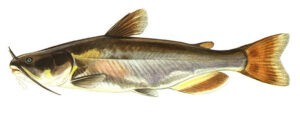
Channel catfish weight will range from 0.5-to-15-pounds in and of the Roosevelt chain lakes, including Canyon Lake. However, the average weight will be between 1-4-pounds.
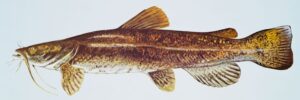
Conversely, “smaller” flathead catfish will weigh in at 15-pounds and can grow around 75-pounds. A flathead survey conducted in 2016 and 2020 caught a flathead that weighed over 48-pounds!
General Catfish Details
Spawn: March-June
Food: Carp, bluegill
Arizona State Record:
Channel catfish – 33 lb., 5.76 oz., 39.5 in., Upper Lake Mary Carson Pete, 3/26/17
Flathead catfish – 76 lb. 8.64 oz., 53.5 in., Bartlett Lake Eddie Wilcoxson, Surprise 04/13/13
Table Quality: Soft white meat. In the summer the meat will taste muddy.
Angling techniques:
Flathead catfish:
- live bait such as smaller carp, full sized bluegill, or tilapia
Channel catfish:
- chicken liver
- hotdogs
- stink bait
- small bluegill
- small carp
Bluegill/ Sunfish
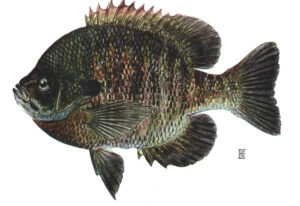 Introduced to Arizona in 1932, the bluegill has teal-blue coloring on the bottom portion of the chin and gill plate. It also has a solid black opercula flap just behind the gill plate.
Introduced to Arizona in 1932, the bluegill has teal-blue coloring on the bottom portion of the chin and gill plate. It also has a solid black opercula flap just behind the gill plate.
Bluegill are found on the shoreline and prefer nearby structures. Bluegill are incredibly aggressive and will quickly attack anything that looks like it could be eaten. Due to their aggressive behavior, they are one of the easiest fish to catch and are a great way to introduce someone to fishing.
Spawn: April and May
Food: Small fish and insects
Arizona State Record: 3 lb. 15.68 oz. 15.75 in., Goldwater Lake. Christopher Ray Mapes, Prescott Valley 5/2/04
Table Quality: Firm, white meat
Angling techniques:
- Worms
- Dough balls
- Slim jim sausages pieces on a small hook (not lying… it really works)
- Small spinners
- Trout flys
Boat Ramps at SUnrise Lake
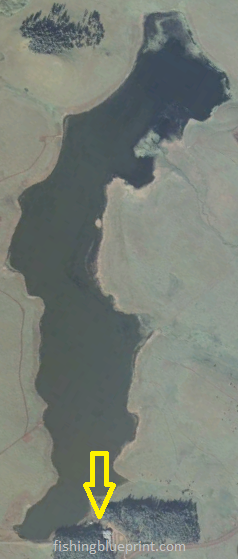
Sunrise Park Lodge and Boat Ramp
160 AZ-273, Greer, AZ 85927
(928) 735-7134
Lanes: 2
Location: western end of the lake
Snacks available: yes
Gas: no
Bathrooms: yes
Showers: no
Electric: no
Camping nearby: yes
Top Tackle Shops Near Sunrise Lake
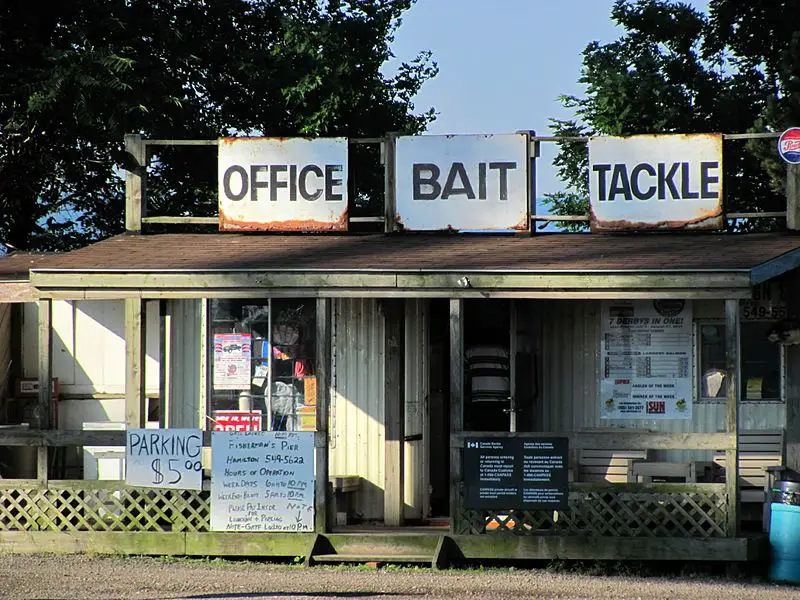
Sunrise Lake Lodge
160 AZ-273, Greer, AZ 85927
(928) 735-7134
Sportsman’s Warehouse
4421 S White Mountain Rd, Show Low, AZ 85901
(928) 537-0800
White Mountain Bait & Tackle
1300 W McNeil, Show Low, AZ 85901
(928) 537-2402
M&M Kayaks
1488 E White Mountain Blvd, Pinetop, AZ 85935
(928) 358-1183
Hon Dah Ski & Outdoor Sport
787 AZ-260, Pinetop, AZ 85935
(928) 369-7669
Places To Camp, Lodging, And RV Parks
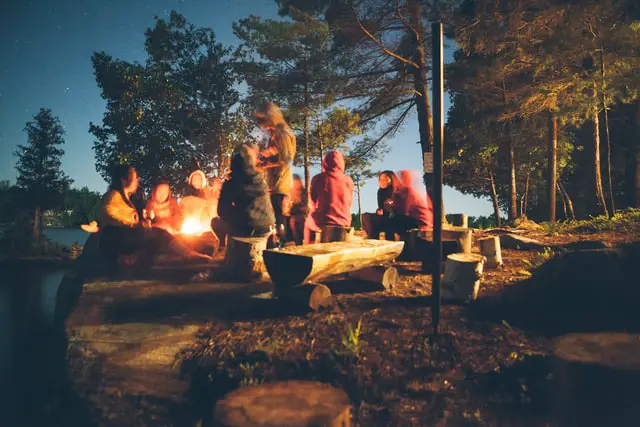
Sunrise Campgrounds
Co Rd 600 &, AZ-273, Whiteriver, AZ 85941
Sunrise Park Resort Campground
Greer, AZ 85927
Reservations – here
A One Lake Campground
McNary, AZ 85930
Other Activities You Can Do at Sunrise Lake
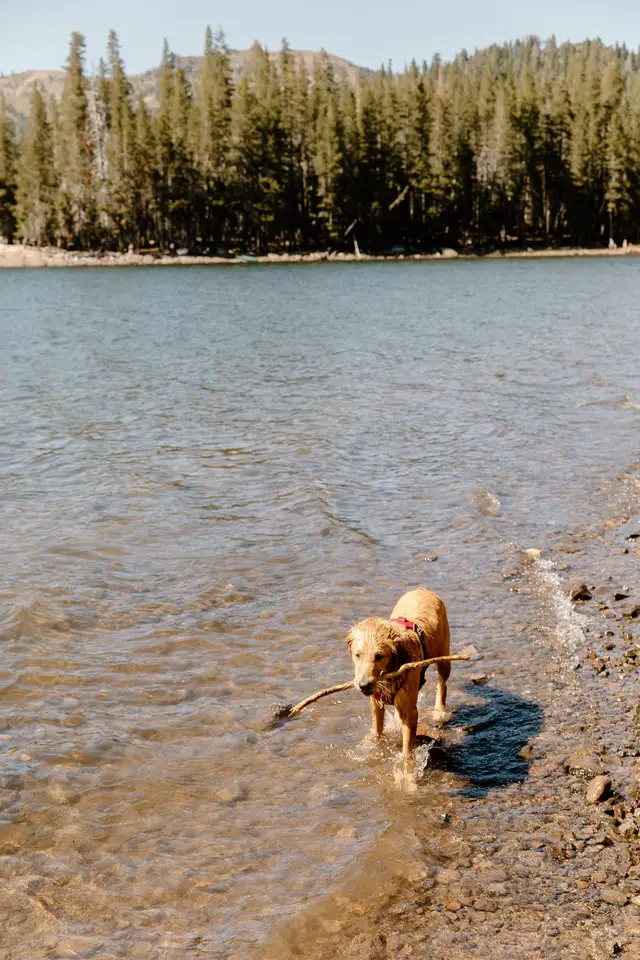
For those who want to chill at the lake…
- Biking
- Bird watching
- Boating
- Skiing
- Kayaking
- Canoeing
- Paddleboarding
- Sailing
- Swimming
- Camping
- Horseshoes
- Picnicking
- Hiking
- Gentle walking trails
- Nature photography trails
- Wildlife viewing
- Mountain biking
- Stargazing
- and most importantly… relaxing.
Other Arizona Related Fishing Articles
- Top 20 Best Places To Fish In Arizona 2023
- Interactive AZ Fishing Map 2023 – Where To Go Fishing In Arizona
- How much does a Arizona fishing license cost?
- Best Tackle Shops In Phoenix Arizona 2023
- Best Bass Fishing Lakes in Arizona 2023 (Voted by Local Anglers!)
- Alamo Lake Fishing Report 2024
- Apache Lake Fishing Report 2024
- Ashurst Lake Fishing Report 2024
- Bartlett Lake Fishing Report 2024
- Bear Canyon Lake Fishing Report 2024
- Big Lake Fishing Report 2024
- Blue Ridge Reservoir Fishing Report 2024
- Canyon Lake Fishing Report 2024
- Chevelon Lake Fishing Report 2024
- Kinnikinick Lake Fishing Report 2024
- Lake Havasu Fishing Report 2024
- Lake Mary Fishing Report 2024
- Lake Pleasant Fishing Report 2024
- Patagonia Lake Fishing Report 2024
- Rainbow Lake Fishing Report 2024
- Roosevelt Lake Fishing Report 2024
- Saguaro Lake Fishing Report 2024
- Show Low Lake Fishing Report 2024
- Sunrise Lake Fishing Report 2024
- Willow Springs Lake Fishing Report 2024
- Woods Canyon Lake Fishing Report 2024
More articles just for you...
Selecting Early Summer Bass Fishing Lures [Avoid 5 Common Mistakes]
A Complete Buyer’s Blueprint On The Best Early Summer Bass Lures On The Market Today! When it comes to bass fishing, choosing the right lure
Early Summer Bass Fishing [Avoid These 3 Sneaky Lies]
Learn these closely guarded secrets early summer bass fishing … and… dramatically boost your advantage over other anglers! Late spring to early summer bass fishing
Fear The Finesse? 7 Ned Rig Fishing Secrets Exposed!
Conquer the Fear of Finesse… and… Unlock the Potential Ned Rig Fishing – TODAY! Fellow Angler… Like most of you I’m pretty set in my
Fishing Spawning Bass [18+ Lures & Gear]
Get Ready For The Spawn Now When bed fishing, stealth is of the biggest essential tip. Instead of racing forward with a trolling motor, anglers
[2024 Editors Choice] Picking The Best Bass Fishing LINE For ANY Budget
What is the best bass fishing line? | What is a good fishing line for bass? The best type of bass fishing line is based
Drift Sock Basics – What It Is A Drift Sock & How To Use It [2024 Quick Start Guide]
What Does A Drift Sock Do? | Why Use A Drift Sock? photo cred: WLUK We’ve ALL been there… you work your butt off the


